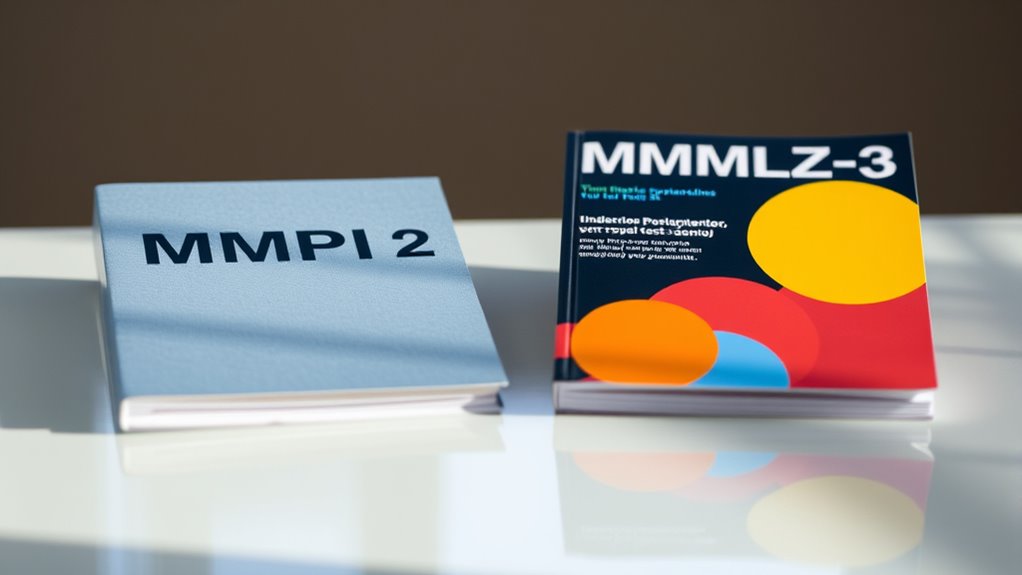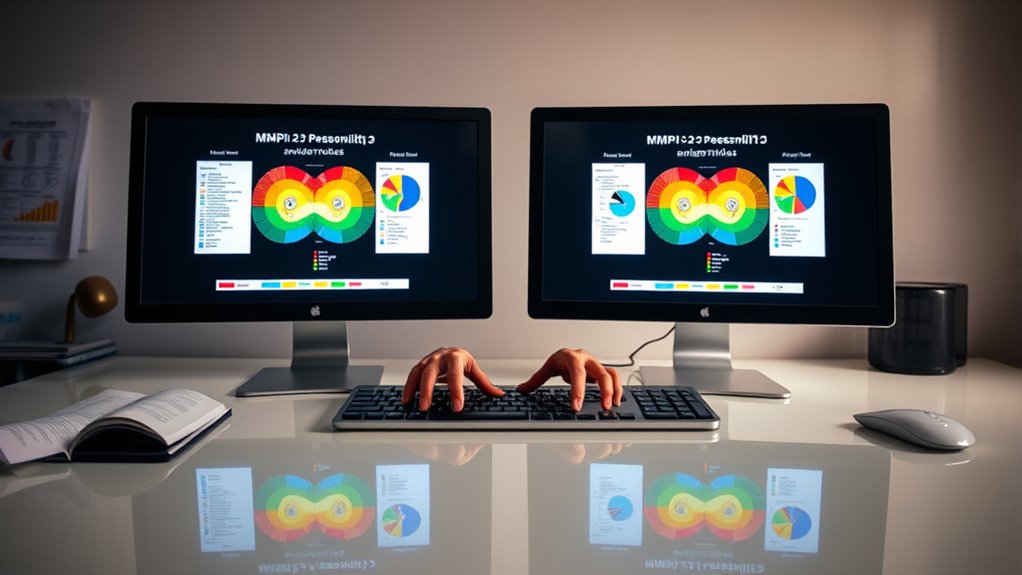The MMPI-3 builds on the MMPI-2 by updating normative data to better reflect today’s diverse populations, making it more accurate and culturally sensitive. It offers improved sensitivity, reducing false results and enhancing interpretation. While the MMPI-2 remains reliable, the MMPI-3’s recent updates guarantee your assessments stay relevant and precise in current societal contexts. To understand how these differences affect your evaluations, keep exploring what makes each version unique.
Key Takeaways
- MMPI-3 incorporates recent normative updates, reflecting current societal demographics, unlike the older MMPI-2 based on earlier populations.
- Both tests assess mental health, but MMPI-3 offers improved sensitivity and reduces false results through enhanced validity scales.
- MMPI-3 expands normative data across diverse age groups and cultures, ensuring more accurate and culturally sensitive assessments.
- The updates in MMPI-3 help recalibrate scales, leading to more precise cutoff scores and interpretation guidelines.
- Overall, MMPI-3 provides more current, reliable, and culturally relevant results compared to the legacy MMPI-2.

If you’re familiar with psychological assessments, you might already know the MMPI-2, a widely used tool for evaluating mental health. As a clinician or researcher, understanding the differences between the MMPI-2 and its successor, the MMPI-3, is essential for guaranteeing accurate assessments. One of the critical aspects to consider is test validity. The MMPI-2, developed in the late 1980s, has proven reliable over decades, but it’s important to recognize that its validity was established based on the normative data available at that time. Normative updates in the MMPI-3 address this by incorporating more recent population data, which helps maintain the test’s relevance and accuracy. These updates guarantee that the normative sample reflects the diversity and demographics of today’s population, which is vital for interpreting results accurately. Additionally, the updated norms help ensure that the test remains sensitive to shifts in societal and mental health patterns over time.
When you administer the MMPI-2, you rely on its established validity scales to identify inconsistent or malingering responses. However, over time, societal changes and shifts in mental health patterns can influence how individuals respond, potentially affecting the test’s validity if norms aren’t updated regularly. The MMPI-3 tackles this issue by integrating normative updates, which recalibrate scales based on current population characteristics. This makes the test more sensitive and precise, reducing the risk of false positives or negatives. As a user, you’ll find that these updates enhance the interpretive accuracy, helping you better understand a client’s true mental health status.
Moreover, the MMPI-3’s normative updates also improve the test’s ability to differentiate between clinical and non-clinical populations. This is crucial because it guarantees that the assessment remains relevant across diverse groups, including different age ranges, cultural backgrounds, and socioeconomic statuses. When you compare results from the MMPI-2 and MMPI-3, you’ll notice that the latter’s updated norms lead to more precise cut-off scores and interpretive guidelines. This means you can have greater confidence in your evaluations, knowing that the normative data reflects the current society. Overall, the MMPI-3’s normative updates are vital for maintaining the assessment’s test validity and ensuring accurate, culturally sensitive results.
Frequently Asked Questions
How Do the MMPI-2 and MMPI-3 Compare in Clinical Accuracy?
You’ll find that the MMPI-3 offers improved psychometric validity and diagnostic precision over the MMPI-2. Its updated norms and revised scales enhance clinical accuracy, making it more reliable for diverse populations. While both tests provide valuable insights, the MMPI-3’s advancements help you make more precise diagnoses, reducing false positives and negatives. Overall, the MMPI-3’s improvements support more effective treatment planning and better clinical decision-making.
Are There Specific Populations Better Suited for MMPI-3?
You’ll find the MMPI-3 better suited for diverse populations, especially those with varied cultural backgrounds, thanks to updated norms and cultural considerations. Its design improves accuracy for individuals from different demographic groups, making it more appropriate for contemporary clinical settings. If you work with multicultural populations, the MMPI-3 offers enhanced population suitability, ensuring your assessments are more valid and culturally sensitive.
How Has Technology Impacted the Administration of Both Tests?
Imagine opening your test results instantly—technology makes that possible. Digital administration streamlines the process, allowing you to complete both the MMPI-2 and MMPI-3 online, saving time and reducing errors. Scoring automation further accelerates results, providing immediate insights. This seamless integration enhances accuracy and convenience, making psychological assessments more efficient and accessible for you. Technology’s impact transforms how you experience and benefit from these crucial tools.
What Are the Cost Differences Between MMPI-2 and MMPI-3?
You’ll find that the pricing differences between the MMPI-2 and MMPI-3 vary, with the newer MMPI-3 generally costing more due to updated content and additional features. Licensing costs for the MMPI-3 tend to be higher, reflecting its advanced technology and expanded norms. These costs can impact your budget, so it’s essential to contemplate the value of improved accuracy and relevance against the expense when choosing between the two tests.
Can the MMPI-3 Replace the MMPI-2 Entirely?
You can replace the MMPI-2 with the MMPI-3, but consider its historical development and cultural considerations. The MMPI-3 offers updated norms and reflects diverse populations better. However, some practitioners might still prefer the MMPI-2 for specific historical data or compatibility with previous assessments. Ultimately, assess your clients’ needs and context before fully shifting, ensuring you leverage the most current and culturally sensitive tools.
Conclusion
As you explore the differences between the MMPI-2 and MMPI-3, picture a evolving landscape—where the old trails of the past blend into the new, vibrant pathways of today. The updated version offers fresh insights, like a clear stream cutting through dense woods, revealing clearer reflections of your mental health. Embrace these changes as tools guiding you through a forest of understanding, helping you navigate your journey with confidence and clarity.
Felicity, our Author, pens in-depth articles and guides that delve into the heart of personal discovery. Her narrative-driven approach weaves together theory, practice, and personal anecdotes, making the journey of self-exploration both relatable and inspiring. Felicity’s contributions help illuminate the path for those seeking a deeper understanding of themselves and their relationships.










